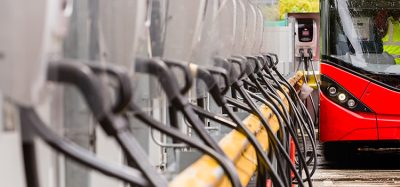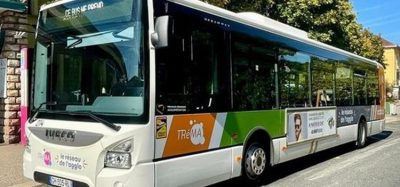The role of micro-mobility in MaaS: First-hand insights from TIER Mobility
- Like
- Digg
- Del
- Tumblr
- VKontakte
- Buffer
- Love This
- Odnoklassniki
- Meneame
- Blogger
- Amazon
- Yahoo Mail
- Gmail
- AOL
- Newsvine
- HackerNews
- Evernote
- MySpace
- Mail.ru
- Viadeo
- Line
- Comments
- Yummly
- SMS
- Viber
- Telegram
- Subscribe
- Skype
- Facebook Messenger
- Kakao
- LiveJournal
- Yammer
- Edgar
- Fintel
- Mix
- Instapaper
- Copy Link
Posted: 8 October 2021 | Alexander Sprey - TIER Mobility, Ludwig Buhr - TIER Mobility | No comments yet
TIER Mobility’s Ludwig Buhr, Lead of Strategic Partnerships, and Alexander Sprey, Senior Market Development Manager, discuss the vital role that micro-mobility plays in the wider public transport system, as well as explain the benefits of integrating micro-mobility services with key mapping and MaaS platforms.
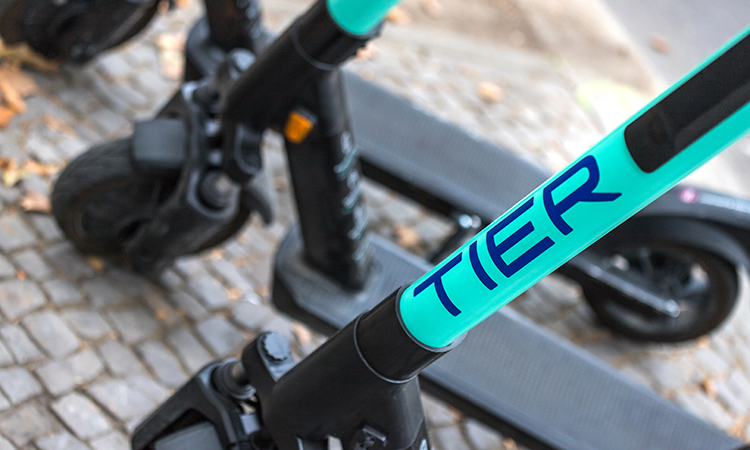

Our mission to change mobility for good is largely about creating strong partnerships to expand everyone’s access to sustainable, easily accessible and multimodal mobility solutions. We strive to create a better-connected tomorrow and to change the mobility sector by not only offering safe and sustainable mobility, but also by helping to connect micro-mobility with public transit and other modes of transport.
The concept of Mobility-as-a-Service offers an alternative to urban mobility that can help to reduce citizens’ dependency on private cars for travelling around in cities”
The concept of Mobility-as-a-Service (MaaS) offers an alternative to urban mobility that can help to reduce citizens’ dependency on private cars for travelling around in cities. MaaS is understood as a seamless service that provides several different transport modes that users can choose from depending on the current transport needs. TIER has taken a very proactive approach to MaaS ever since the organisation was founded in 2018. As of today, we have integrated our services into more than 30 MaaS platforms, which makes us the most integrated micro-mobility player in Europe.
Micro-mobility plays a vital role, as it provides crucial first- and last-mile solutions to make MaaS more accessible, to feed public transport services and, moreover, to increase the overall adoption of sustainable mobility. About one out of three TIER riders predominantly use e-scooters during the week for commuting or running personal appointments, and almost half of TIER users take e-scooters as a first-/last-mile solution, combining it with other modalities. However, many people still drive their car to connect with main transport hubs. By linking our services to other mobility service providers (MSPs) via multilevel integration on a physical, digital and commercial level, we can significantly benefit mobility in urban environments and, thus, contribute towards the MaaS vision.
How can we improve the connection between micro-mobility and other modes of transport through MaaS integrations?
At the highest level, we distinguish between deep link and deep integration. Integration via deep links displays the mobility service provider’s vehicles in the MaaS app. In order to book, use and pay for the vehicle, the user needs to be redirected to the respective app of the MSP.
Deep integrations, however, allow users to book and pay for their journey directly in the MaaS app, without the need to switch to the MSP app. This is the most advanced level of integration. Figure 1 visualises the different levels of integrations, including a few examples from the MaaS market. In general, deep link integrations can be defined as Level 1 and deep integrations as Levels 2, 3 and 4 – depending on the complexity of the MaaS project. In the following, we will highlight a few of our most recent MaaS partnerships.
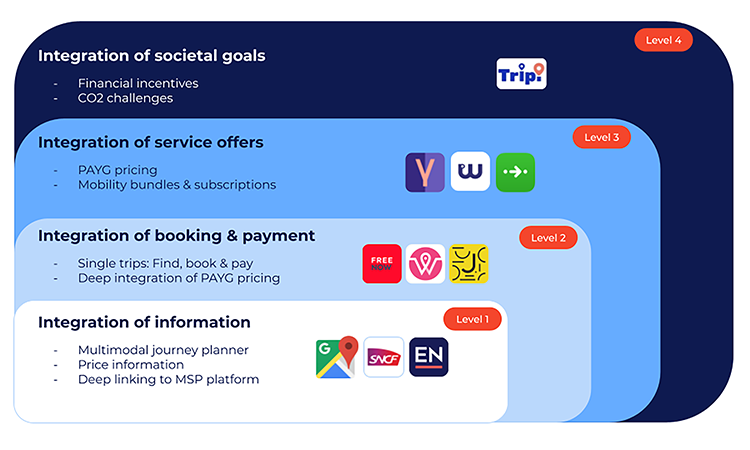

Figure 1: Proposed MaaS topology, including Levels 1 to 4 (by Sochor et al, 2018), and examples. Credit: TIER Mobility
Google Maps: Extending the reach of micro-mobility to the world’s most popular mapping service
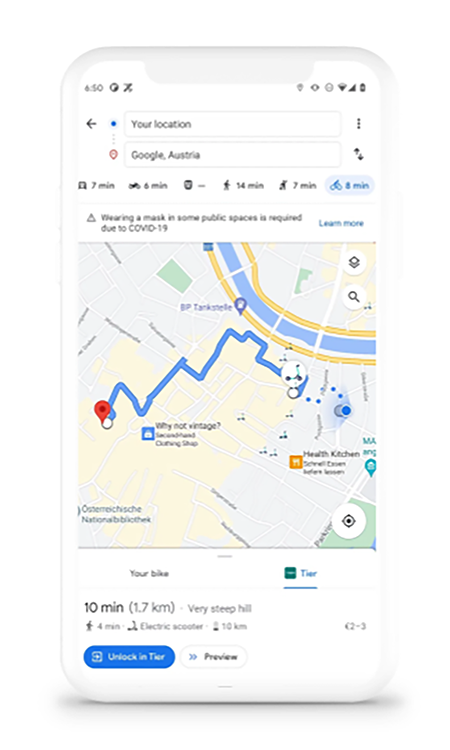

Screenshot of TIER’s integration in Google Maps. Credit: TIER Mobility.
Through our latest partnership with Google, we’re creating high visibility for TIER e-scooters and e-bikes within Google Maps. When planning their journey from A to B, users increasingly look for optimised ways to combine different forms of transportation, from walking and public transport to electric scooters and cars. By increasing the visibility of TIER’s electric scooters and bikes within Google Maps, we’re helping to ensure that riders have access to the form of transportation that best suits their daily mobility needs.
Since July 2021, we have started to offer our vehicles when planning routes for the ‘first and last mile’ in more than 40 European Google Maps cities. Under the tab for cycling directions, users can locate nearby TIER e-scooters and e-bikes directly in Google Maps, along with helpful information like a cost estimate and anticipated walking distance to the vehicle, the charging status of each vehicle and the expected overall arrival time to the final destination. To start the ride, users will be redirected to the TIER app, where they can unlock the vehicle and start their journey.
FREE NOW: A joint commitment to more fully integrated multimodality
While the integration of mobility information (Level 1 integration) is a great first step to enable multi and intermodal travel, it is only a first step towards our vision of MaaS. The next crucial step is to integrate not only information, but also booking and payment functions (Level 2 integration). Without a so-called deep integration of mobility services, a MaaS solution would only be a simple aggregator rather than a multimodal ‘one-stop-shop’ for mobility. Our experience with more than 30 integrations, out of which only 35 per cent are currently deep integrations, demonstrates the need for more deep integrations: on average, our deep integrations generate 30 times more ridership than deep link integrations.
Our strategic partnership with FREE NOW is a strong commitment to more deeply integrated multimodality. Since March 2021, our e-scooters and e-mopeds are fully integrated into the FREE NOW platform in more than 20 cities in Germany, France, Poland, the UK and Austria.
Whim: Mobility subscriptions as a compelling alternative to the private car
While we see an increasing number of platforms and MSPs going for deep integrations, the majority of MaaS solutions currently only offer the usage of all integrated mobility services via a pay-as-you-go (PAYG) option. A combined usage and payment of different mobility modes via bundles and multimodal subscriptions (Level 3 integration) is currently more of an exception in the MaaS market, but often considered as a prerequisite to make MaaS a real alternative to private cars.
Mobility bundles are already being successfully piloted in Europe’s MaaS environment: Whim is one of these platforms that is pioneering MaaS. The Finnish company launched its service in 2016 in Helsinki and intends to transform the way that people move by fulfilling their complex mobility needs with a single, all-inclusive season ticket. According to Peter Kuhn, Director – New Ventures at MaaS Global, the adoption of Whim’s mobility tickets looks promising, with 30 per cent of users also becoming subscribers.
We can support the positive numbers with our own data from the Level 3 integration in the Yumuv app in Switzerland. Yumuv bundles services from shared mobility with public transport from the Swiss Federal Railways (SBB) and the local public transport providers in Basel, Bern and Zürich. Our data underlines that, between August 2020 and March 2021, 65 per cent of all TIER rides taken via the Yumuv app were performed by subscribers and not PAYG users.
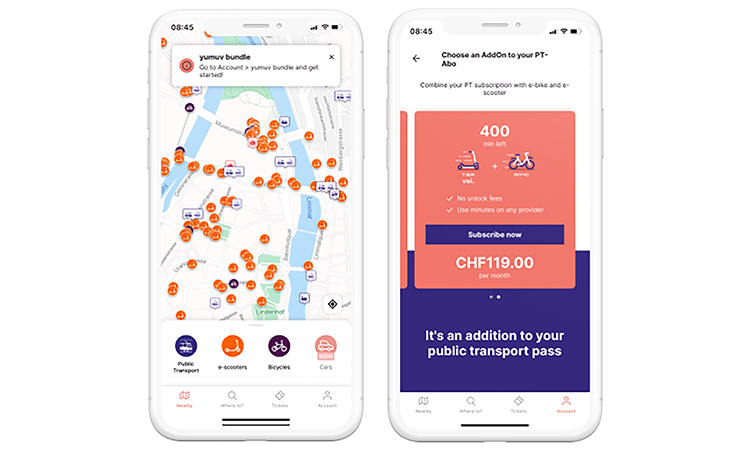

Screenshots of TIER’s integration in Switzerland’s multimodal app Yumuv. Credit: TIER Mobility.
Integration beyond the digital level: Mobility stations with BVG in Berlin
Beyond connecting our services on a digital level, a better physical integration is needed in order to support the usage of MaaS. TIER research data suggests that, among prospective users who consider safety a barrier to use, lack of protection from traffic is a primary concern (68 per cent of respondents). In addition, nearly half of citizens support encouragement from cities to promote the use of multiple modes of transport beyond cars. Thus, market adoption can also be supported by setting up mobility hubs in residential areas and promoting the usage of MaaS. BVG’s Jelbi project takes MaaS to the next level by collaborating with Berlin’s real estate sector to implement mobility hubs in building projects across Berlin. Our data from Jelbi stations in Berlin indicates that mobility hubs are more frequently used as a starting point (65 per cent) than as an ending point (35 per cent) of the ride.
As more COVID-19 restrictions lift and traffic increases once again in many European countries, offering more alternative and integrated travel options helps citizens to save time getting to their destination and reduces the need for a private car for first- and last-mile journeys”
As more COVID-19 restrictions lift and traffic increases once again in many European countries, offering more alternative and integrated travel options helps citizens to save time getting to their destination and reduces the need for a private car for first- and last-mile journeys. MaaS platforms that integrate trip planning and even end-to-end booking, electronic ticketing and payment services across all modes of urban transport can play a crucial role here. In order to reach the next level of MaaS adoption, more deeply integrated mobility options and further research for designing intelligent pricing bundles is, among other factors, needed to reach the next level.
Last but not least, more investment from public stakeholders in physical infrastructure that supports the adoption of public transport and shared (micro) mobility is a prerequisite for creating a better connected mobility ecosystem and changing the mobility sector for good.






Related topics
Accessibility, Mobility Services, Multimodality, On-Demand Transport, Passenger Experience, Sustainable Urban Transport
Issue
Issue 3 2021
Related modes
Bikes & Scooters
Related organisations
Berliner Verkehrsbetriebe (BVG), FREE NOW, Google, Google Maps, Swiss Federal Railways (SBB), TIER Mobility, Whim, Yumuv
Related people
Alexander Sprey, Ludwig Buhr, Peter Kuhn






